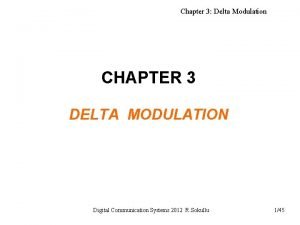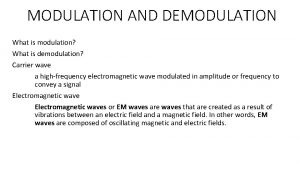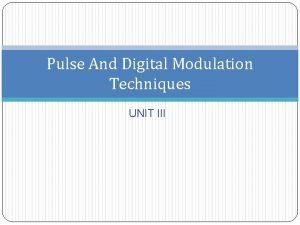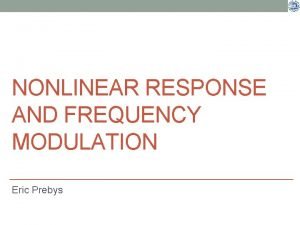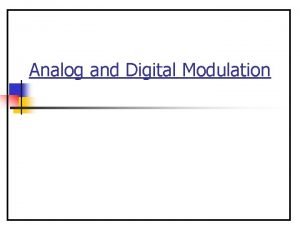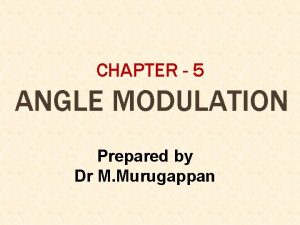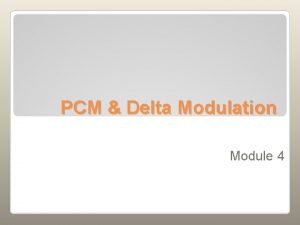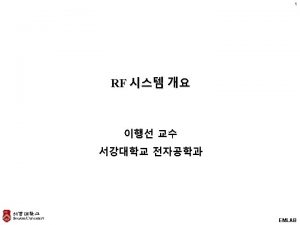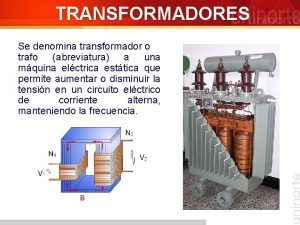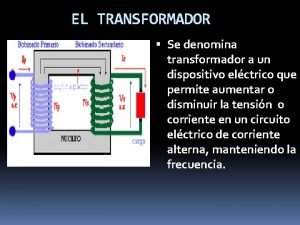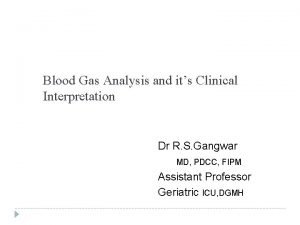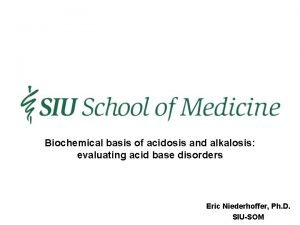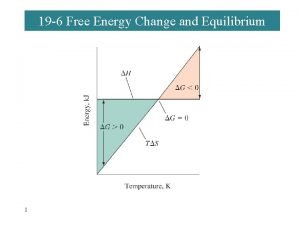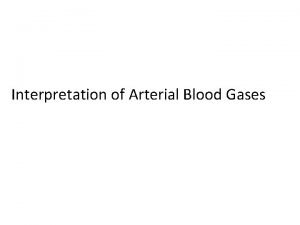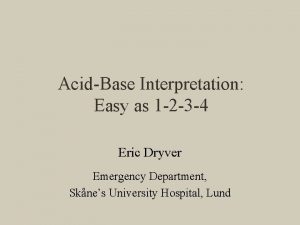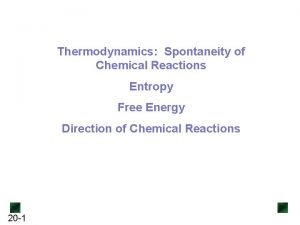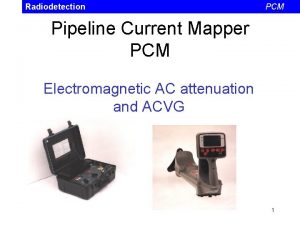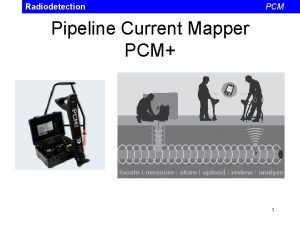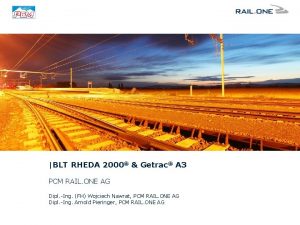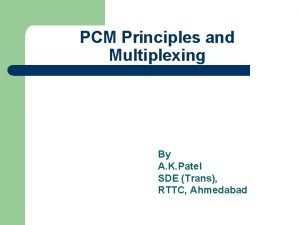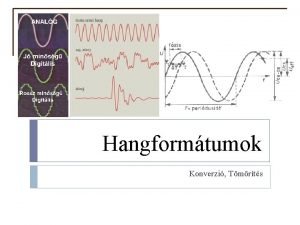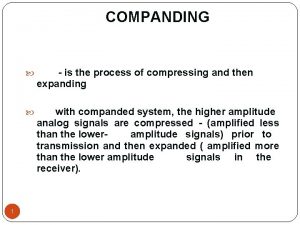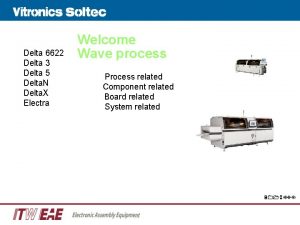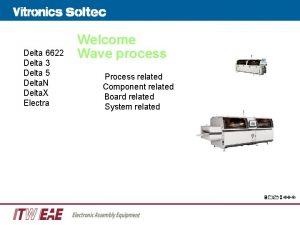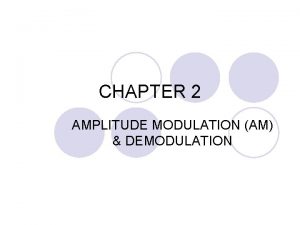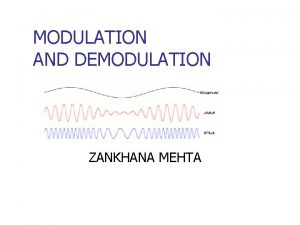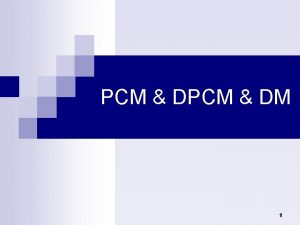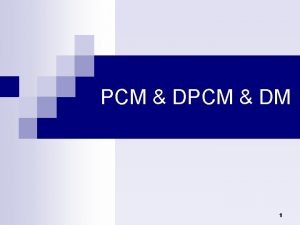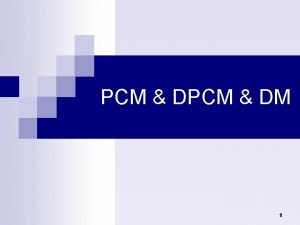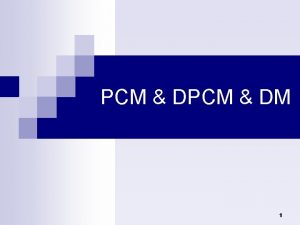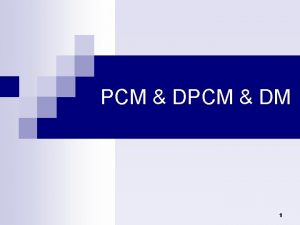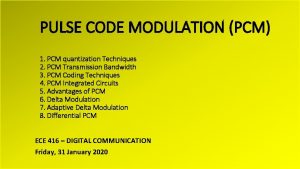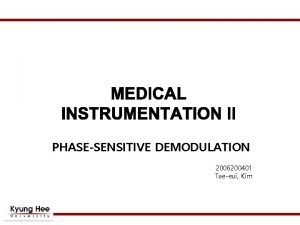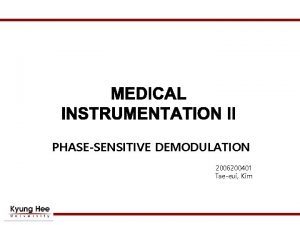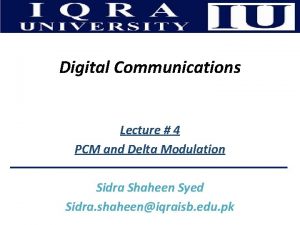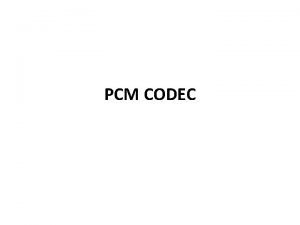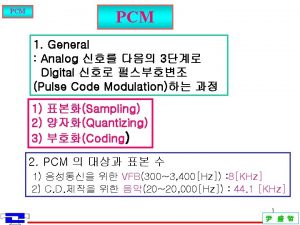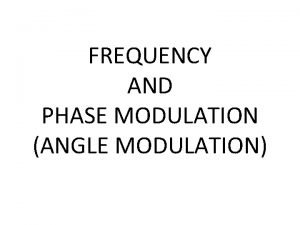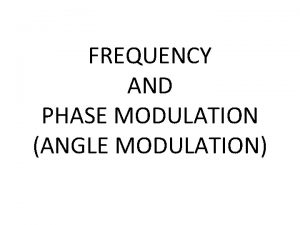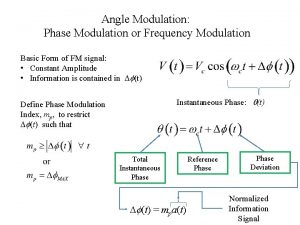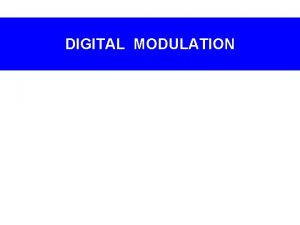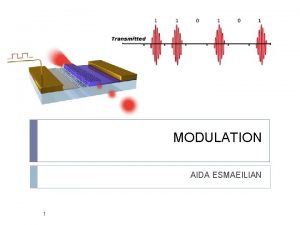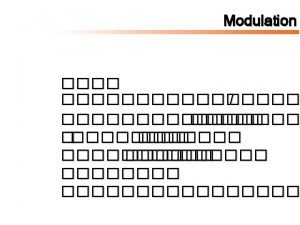Chapter 1 PCM and Delta Modulation and Demodulation







































- Slides: 39

Chapter 1: PCM, and Delta Modulation and Demodulation

Learning Objectives LO 1. 1 - Understand various practical aspects of sampling such as methods of sampling, Nyquist sampling theorems, aliasing, PAM/TDM application. LO 1. 2 - Analyze the functional processes (sampling, quantization and binary encoding) of pulse-code modulation (PCM) technique. LO 1. 3 - Generate variants of PCM such as differential PCM (DPCM) and adaptive differential PCM (ADPCM). LO 1. 4 - Implement delta modulation and adaptive delta modulation techniques.

Introduction • Digital representation of analog signals Analog signal source Waveform Coding (Codec) Digital signal destination Fig. 1 A Analog-to-Digital Encoding

Advantages of Digital Transmissions Noise immunity Error detection and correction Ease of multiplexing Integration of analog and digital data Use of signal regenerators Data integrity and security Ease of evaluation and measurements More suitable for processing ……. .

Disadvantages of Digital Transmissions More bandwidth requirement Need of precise time synchronization Additional hardware for encoding/decoding Integration of analog and digital data Sudden degradation in Qo. S Incompatible with existing analog facilities

A Typical Digital Communication Link Fig. 1 B Block Diagram

1. 1 Practical Aspects of Sampling 1. 1. 1 Sampling Theorem 1. 1. 2 Methods of Sampling 1. 1. 3 Significance of Sampling Rate 1. 1. 4 Anti-aliasing Filter 1. 1. 5 Applications of Sampling Theorem – PAM/TDM

1. 1. 1 Sampling Theorem for Baseband Signal - A baseband signal having no frequency components higher than fm Hz may be completely recovered from the knowledge of its samples taken at a rate of at least 2 fm samples per second, that is, sampling frequency fs ≥ 2 fm. The minimum sampling rate fs = 2 fm samples per second is called the Nyquist sampling rate. A baseband signal having no frequency components higher than fm Hz is completely described by its sample values at uniform intervals less than or equal to 1/(2 fm) seconds apart, that is, the sampling interval Ts ≤ 1/(2 fm) seconds.

…. . Sampling Theorem for Bandpass Signal - If an analog information signal containing no frequency outside the specified bandwidth W Hz, it may be reconstructed from its samples at a sequence of points spaced 1/(2 W) seconds apart with zero-mean squared error. The minimum sampling rate of (2 W) samples per second, for an analog signal bandwidth of W Hz, is called the Nyquist rate. The reciprocal of Nyquist rate, 1/(2 W), is called the Nyquist interval, that is, Ts = 1/(2 W). The phenomenon of the presence of high-frequency component in the spectrum of the original analog signal is called aliasing or simply foldover.

1. 1. 2 Methods of Sampling Ideal sampling an impulse at each sampling instant Fig. 1. 1. 1 Ideal Sampling

…. . Methods of Sampling Natural sampling - a pulse of short width with varying amplitude with natural tops Fig. 1. 1. 2 Natural Sampling

…. . Methods of Sampling Flat-top sampling - a pulse of short width with varying amplitude with flat tops Fig. 1. 1. 3 Flat-top Sampling

1. 1. 3 Significance of Sampling Rate When fs < 2 fm, spectral components of adjacent samples will overlap, known as aliasing Fig. 1. 1. 4 An Illustration of Aliasing

1. 1. 4 Antialiasing Filter An anti-aliasing filter is a low-pass filter of sufficient higher order which is recommended to be used prior to sampling. Fig. 1. 1. 5 Minimizing Aliasing

1. 1. 5 Application of Sampling Theorem – PAM/TDM Figure 1. 1. 10 Design of PAM/TDM System

1. 2 Pulse Code Modulation (PCM) 1. 2. 1 Block Diagram of PCM 1. 2. 2 PCM Sampling 1. 2. 3 Quantization of Sampled Signal 1. 2. 4 Encoding of Quantized Sampled Signal 1. 2. 5 PCM System using Codec 1. 2. 6 PCM System Parameters

1. 2. 1 Figure 1. 2. 1 Block Diagram of PCM System Block Diagram of PCM

1. 2. 2 Figure 1. 2. 3 The Process of Natural Sampling PCM Sampling

1. 2. 3 Quantization of Sampled Signal s(t) sq(t) VH s 7 Δ 7 s 6 Δ 6 s 5 Δ 5 s 4 Δ 4 s 3 Δ 3 s 2 Δ 2 s 1 Δ 1 s 0 Δ 0 L 67 Figure 1. 2. 6 Operation of Quantization L 56 L 45 sq(t) s(t) L 34 L 23 L 12 Δ/2 L 01 Δ VL t

Quantization Error and Classification Quantization is the conversion of an analog sample of the information signal into discrete form. Thus, an infinite number of possible levels are converted to a finite number of conditions. Quantization error is defined as the difference between rounding off sample values of an analog signal to the nearest permissible level of the quantizer during the process of quantization. Classification of Quantization Process Uniform quantization Non-uniform quantization

Characteristics of Compressor, Uniform and Non-uniform Quantizer Figure 1. 2. 9 Figure 1. 2. 10

μ-law and A-law Compression Characteristics Figure 1. 2. 11 Figure 1. 2. 12

1. 2. 4 Encoding of Quantized Sampled Signal Figure 1. 2. 13 PCM – Functional Blocks

1. 2. 5 PCM System using Codec CODEC LPF PCM signal Digital MUX A/D converter (Tx side) Tx signal From other codecs Hybrid D/A converter (Rx side) Analog signal IN/OUT Digital De. MUX Rx signal LPF To other codecs Figure 1. 2. 15 Functional Block Diagram

1. 2. 6 PCM System Parameters PCM Data Rate (bps) = 2 nfm PCM Bandwidth (Hz) = (1/2) PCM Data Rate = nfm Dynamic Range (d. B) = 20 log (2 n – 1) Coding Efficiency (%) = [(minimum bits)/(actual bits)] x 100 Where n is number of PCM encoding bits and fm is the highest frequency component of information signal

1. 3 DPCM and Adaptive DPCM 1. 3. 1 DPCM Transmitter with Predictor 1. 3. 2 DPCM Receiver with Predictor 1. 3. 3 Adaptive Differential PCM

DPCM Transmitter and Receiver with Predictor The difference in the amplitude levels of two successive samples is transmitted rather than the absolute value of the actual sample Figure 1. 3. 1 DPCM Transmitter with Predictor Figure 1. 3. 2 DPCM Receiver with Predictor

1. 4 Delta Modulation 1. 4. 1 Slope Overload and Granular Noise 1. 4. 2 DM Encoder and Decoder 1. 4. 3 Delta-Sigma Modulation 1. 4. 4 Adaptive Delta Modulation (ADM) 1. 4. 5 Comparison of PCM and DM Techniques

Essence of Delta Modulation (DM) Delta modulation (DM) uses a single-bit DPCM code to achieve digital transmission of analog signals Figure 1. 4. 1 An Ideal Delta Modulation Waveform

Delta Modulation Encoding Figure 1. 4. 2 Basic Concept of Linear DM Encoding

DM Encoding Waveform Figure 1. 4. 3

Delta Modulation Decoding Figure 1. 4. 4 Basic Concept of DM Decoding

REMEMBER: In DM, the step sizeand is related to the sampling 1. 4. 1 Slope Overload Granular Noise frequency. In order to avoid slope overload distortion, the maximum slope of the staircase approximation must be equal to or greater than the maximum slope of the signal. Figure 1. 4. 5 Figure 1. 4. 6

1. 4. 2 DM Encoder and Decoder Figure 1. 4. 7 Figure 1. 4. 8

1. 4. 3 Delta-Sigma Modulation Combines the operation of transmitter integrator (in the accumulator part) and the receiver integrator, and then shift it prior to the encoder in the transmitter The input to the delta modulator is actually the difference between the integral of the analog signal and the integrated output pulses. High over-sampling is employed in sigma-delta modulation systems, they are mostly useful in low-frequency applications such as digital telephony, digital audio encoders (compact-disc) and digital spectrum analyzers.

1. 4. 4 Adaptive Delta Modulation (ADM) The step size is automatically varied, depending on the level of the derivative of the input analog signal The receiver must be able to adapt step sizes in exactly the same manner as the transmitter A common algorithm followed for an ADM is that when three consecutive 1 s or 0 s occur, the step size is increased or decreased by a factor of 1. 5. NOTE: Continuous Variable Slope Delta Modulation (CVSDM) is an improvement over ADM.

1. 4. 5 Comparison of PCM and DM Techniques S. No. 1. Parameter Number of bits per PCM 4/8/16 bits sample DPCM More than one bit but DM ADM One bit less than PCM 2. Number of levels Depends on number of bits Fixed number of levels Two levels 3. Step size Fixed or variable Fixed Variable 4. Transmission bandwidth More bandwidth needed Lesser than PCM Lowest 5. Feedback Does not exist Exists 6. Quantization noise depends Quantization noise & slope overload & Quantization noise only noise/distortion on number of bits slope overload granular noise Complexity of Complex Simple 7. implementation Simple

About the Author T. L. Singal graduated from National Institute of Technology, Kurukshetra and post-graduated from Punjab Technical university in Electronics & Communication Engineering. He began his career with Avionics Design Bureau, HAL, Hyderabad in 1981 and worked on Radar Communication Systems. Then he led R&D group in a Telecom company and successfully developed Multi-Access VHF Wireless Communication Systems. He visited Germany during 1990 -92. He executed international assignment as Senior Network Consultant with Flextronics Network Services, Texas, USA during 2000 -02. He was associated with Nokia, AT&T, Cingular Wireless and Nortel Networks, for optimization of 2 G/3 G Cellular Networks in USA. Since 2003, he is in teaching profession in reputed engineering colleges in India. He has number of technical research papers published in the IEEE Proceedings, Journals, and International/National Conferences. He has authored three text-books `Wireless Communications (2010)’, `Analog & Digital Communications (2012)’, and `Digital Communication (2015) with internationally renowned publisher Mc. Graw-Hill Education.

THANKS!
 Delta modulation conclusion
Delta modulation conclusion Modulation and demodulation
Modulation and demodulation Pulse code modulation and demodulation
Pulse code modulation and demodulation Pulse code modulation and demodulation
Pulse code modulation and demodulation Spectragram
Spectragram Amplitude modulation vs frequency modulation
Amplitude modulation vs frequency modulation Amplitude modulation vs frequency modulation
Amplitude modulation vs frequency modulation Advantages of angle modulation
Advantages of angle modulation Advantage and disadvantage of dpcm
Advantage and disadvantage of dpcm Snr formula for delta modulation
Snr formula for delta modulation Synchronous demodulation
Synchronous demodulation Como se abrevia transformador
Como se abrevia transformador Conexion delta delta en transformadores
Conexion delta delta en transformadores G=g+rtlnq
G=g+rtlnq Free energy
Free energy Metabolic alkalosis abg example
Metabolic alkalosis abg example Delta delta gap
Delta delta gap Delta delta gap
Delta delta gap Delta ratio in abg
Delta ratio in abg Osmolar gap
Osmolar gap Delta g = delta g not + rtlnq
Delta g = delta g not + rtlnq Delta ratio in abg
Delta ratio in abg Co3h+
Co3h+ Delta ag delta hco3
Delta ag delta hco3 Delta to wye conversion balanced
Delta to wye conversion balanced Delta h delta s
Delta h delta s Electricial engineering chapter
Electricial engineering chapter Pcm pipeline
Pcm pipeline Pipeline defect mapper
Pipeline defect mapper Cat devant une anémie
Cat devant une anémie Pcm tools in project management
Pcm tools in project management Pulsos: pam, ppm, pwm, pcm, ask, fsk, psk, qam
Pulsos: pam, ppm, pwm, pcm, ask, fsk, psk, qam Rheda 2000
Rheda 2000 Pcm multiplexing
Pcm multiplexing Bitfolyam vagy pcm
Bitfolyam vagy pcm The capacity of the
The capacity of the Pcm bandwidth formula
Pcm bandwidth formula Companding in pcm
Companding in pcm Pcm imaginer
Pcm imaginer Chess.pcm
Chess.pcm
